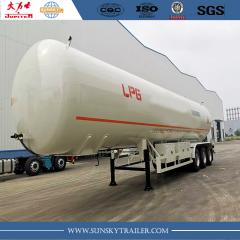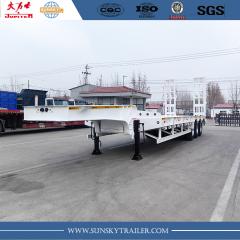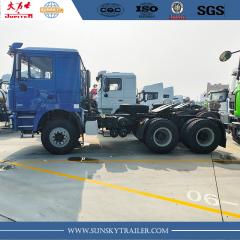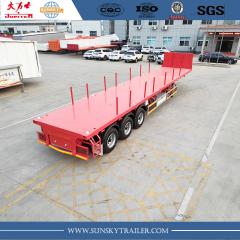-
 3 Axle Lpg Gas Tank Semi Trailer
3 Axle Lpg Gas Tank Semi Trailer
-
 Low Bed Trailer
Low Bed Trailer
-
 SHACMAN F3000 Tractor Truck
SHACMAN F3000 Tractor Truck
-
 Flatbed Pillar Trailer
Flatbed Pillar Trailer
SUNSKY VEHICLE, a manufacturer of flatbed semi-trailers, has found that the Flatbed Pillar Trailer i...
A fuel tanker trailer is an oil tanker that uses a traction head to connect the trailer part. Compared with the ordinary single tanker trailer, the fuel tanker trailer can effectively improve the transportation efficiency. In the case of the same tonnage, the transportation cost is reduced and the fuel consumption is saved. It is mainly composed of tank body, frame, traction device, support device, electrical system, walking system, protective device, accessories, etc.
The fuel tanker trailer is divided into two parts, tank part and support tank skeleton or driving part, semitrailer tank rear is roughly the same, there are two Bridges (two axes), after three Bridges (three axes), according to the need to choose traction head.

The tank body of fuel tanker trailer
1. The tank body is made of 4mm or 6mm high-quality carbon steel produced by the iron and steel company according to the national standard. It can also produce heating and thermal insulation series tanks.
2. Alcohol and chemical tankers are made of stainless steel imported from South Korea, with a thickness of 4mm-5mm.
3. Various types of hydrochloric acid, sulfuric acid and lye tank trucks are made of plastic, with a thickness of 12mm – 22mm.
4. There are multiple anti-wave baffles in the tank. The use of high-pressure gas leak detection makes the tank have the characteristics of high strength, stable center of gravity, and safe and stable vehicle transportation.
5. Centrifugal pumps, gear pumps and stainless steel pumps can be selected according to the purpose of the tanker, which have the characteristics of large flow rate and fast suction speed.
6. Single-counting and double-counting flow meters can be used for the measurement of oil tankers, and tax-controlled computerized refueling machines can also be installed, with 10-15 meters of automatic retractable return reels, equipped with refueling guns. Edible oil products can be measured with a computerized edible oil product meter.
Features of fuel tanker trailer
· Medium: gasoline, diesel, etc.
· Tank material: carbon steel, aluminum alloy.
· Tank shape: oval, round.
· Unloading system: bottom loading system, oil and gas recovery system, anti-overflow system.
·Features: light weight, high load quality, high transportation efficiency and operating income, good electrical conductivity, high safety performance, no rust, no pollution to the shipping medium.

fuel tanker trailer special configuration
Bottom loading system (tank)
Principle comparison of conventional top loading and unloading and bottom loading and unloading systems
·Top loading method: operating on the top of the tank, personnel are unsafe, oil and gas escape into the atmosphere, and there is a potential safety hazard.
·Bottom loading method: operate on the ground, safe and efficient internal circulation of oil and gas, no danger of explosion.
Components of a bottom loading system
· Bottom loading and unloading system: Pneumatically controlled foot valve, API joint valve.
· Oil and gas recovery system: oil and gas recovery joint, oil and gas recovery valve, side plate vent valve.
· Anti-overflow system: sensor, socket control system.

On-board pump loading and unloading system (oil tank)
Purpose: Pump the liquid in the tank into the storage tank higher than the tank car, and suck the liquid in the storage tank lower than the tank car into the tank
Pump drive type:
· PTO drive (for bicycles).
·380V motor drive (for semi-trailer or bicycle).
Pump Line Function:
· Through the opening and closing of steel pipes and different ball valves, the pump in and pump out functions are realized.
·Connect the outlet of the tank to the inlet and outlet of the pump through a hose to realize the function of pump in and pump out.

Valves and Emergency Foot Valves
For tank trucks loaded with toxic and corrosive media, the pressure rating of their valves is not lower than PN1.6MPa. The discharge valve should be a tandem double-channel valve, one of which is a built-in valve and installed at the bottom of the tank.
In the new standard, the oil tanker is also required to be equipped with a bottom valve to avoid increasing the severity of the accident due to leakage. Emergency bottom valve: It is installed at the inlet of the pipeline at the bottom of the tank. When the discharge pipeline encounters accidental damage, the emergency bottom valve is still closed and the medium will not leak. There are two types of emergency bottom valve, pneumatic and manual, which are easy to operate.

Tank Top Safety Accessories
·Shoulder guards on the top of the tank body: There are shoulder guards on both sides of the tank top. The shoulder guards are higher than all the accessories on the tank top, and their strength can bear 2 times the total weight of the tanker. damage to avoid liquid leakage due to damaged tank top accessories.




